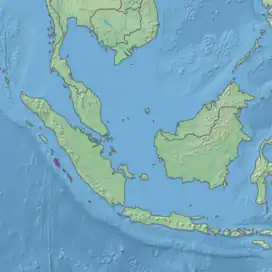Mentawai Islands rain forests
The Mentawai Islands rain forests is a tropical moist broadleaf forest ecoregion in Indonesia. It covers the Mentawai Islands, an archipelago in the Indian Ocean off the west coast of Sumatra. The islands have been separated from Sumatra since the mid-Pleistocene period, and their geographic isolation allowed the evolution of several endemic species, including 17 endemic mammals.[1]
| Mentawai Islands rain forests | |
|---|---|
 Siberut Island | |
 Mentawai Islands rain forests (in purple) | |
| Ecology | |
| Realm | Indomalayan |
| Biome | Tropical and subtropical moist broadleaf forests |
| Geography | |
| Area | 6,513 km2 (2,515 sq mi) |
| Country | Indonesia |
| Conservation | |
| Conservation status | Critical/endangered,[1] nature could reach half protected[2] |
| Protected | 30.94%[3] |
Geography

The ecoregion has an area of 6,513 square kilometers,[3] which includes all the Mentawai Islands, the largest of which are Siberut, Sipura, North Pagai, and South Pagai, as well as Enggano Island further to the southeast.[1] The islands lie 80 to 120 km from the west coast of Sumatra.
Climate
The islands have a tropical rainforest climate.[1] Average annual rainfall is approximately 4,500 mm, with an October to March wet season. Temperatures average about 30°C year-round.[2]
Flora
The forests have a closed canopy about 36 metres high, with emergent trees rising 45 metres or more. Trees of the dipterocarp family are common canopy and emergent trees. Emergent trees include species of the dipterocarp genera Dipterocarpus and Shorea, and species of Koompassia, Sindora, and Dialium. Canopy trees include species of Mallotus, Knema, Santiria, Bhesa, Eugenia, Baccaurea, Dillenia, Artocarpus, and Horsfieldia.
Fauna
There are six endemic primates in the ecoregion – Kloss's gibbon (Hylobates klossii), Mentawai macaque (Macaca pagensis), Siberut macaque (Macaca siberu), Mentawai langur (Presbytis potenziani), Siberut langur (Presbytis siberu), and pig-tailed langur (Simias concolor).[4] Other endemic mammals include the Mentawai treeshrew (Tupaia chrysogaster), Sipora flying squirrel (Hylopetes sipora), Mentawai long-tailed giant rat (Leopoldamys siporanus), Pagai spiny rat (Maxomys pagensis), Mentawai rat (Rattus lugens), Mentawi flying squirrel (Iomys sipora), Siberut flying squirrel (Petinomys lugens), and short-headed leaf-nosed bat (Hipposideros breviceps).[2] Other native mammals include the Asian palm civet (Paradoxurus hermaphroditus) and crab-eating macaque (Macaca fascicularis).[1]
There are ver 250 native species of birds on the islands. the Mentawai scops owl (Otus mentawi) is the only known endemic species.[2]
Protected areas
30.94% of the ecoregion is in protected areas.[3] These include Siberut National Park, which covers the western portion of Siberut, including the islands' largest areas of intact forest in northwestern Siberut.[2]
References
- "Mentawai Islands rain forests". Terrestrial Ecoregions. World Wildlife Fund.
- Wikramanayake, Eric. Mentawai Islands Rainforests. One Earth. Accessed 5 April 2023.
- Mentawai Islands rain forests. DOPA Explorer. Accessed 5 April 2023.
- Whittaker, D. 2006. A conservation action plan for the Mentawai primates. Primate Conservation 20: 95–105.